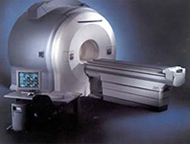NIDA Low-cost fMRI-safe Virtual Reality Glasses
 |
Neuroimaging techniques such as functional magnetic resonance imaging (fMRI), which are being used to understand how drugs of abuse alter brain functioning, are being combined with stimulus-producing hardware such as virtual reality (VR) goggles to study task-related assessments of brain activation. For drug abuse research, study areas include brain/behavior correlations, cue exposure response, and neural regeneration post-usage. Other clinical research uses include brain plasticity research, rehabilitation of brain-injured patients, and spatial navigation.
The Virtual Reality Medical Center (VRMC) will develop low-cost, easy-to-use, fully integrated virtual reality glasses for use inside an MRI magnet. The device will consist of the computer hardware, the VR glasses, and the wireless peripheral device used to interact with and explore the virtual world. Included with the device will be eye-tracking software and a currently existing VRMC virtual environment. The system will be inexpensive, easy to use, upgradeable, and reliable.
In Phase I, VRMC constructed a prototype of the low-cost fMRI-safe VR glasses, tested its safety in the laboratory, and performed human factors testing. In Phase II, VRMC plans to refine its Phase I prototype of low-cost fMRI-safe VR glasses; test their optical/visual, biodynamic, and acoustical properties in the laboratory; and perform clinical testing on 65 participants. This will test the physical performance of the VR glasses and determine whether participants are able to experience a strong feeling of presence and immersion in the virtual world during an fMRI brain scan.
Based on this project to create these fMRI-safe VR glasses, VRMC won a Technology Niche Assessment Program award from the National Institutes of Health in Fall 2006, and its 3rd NIH-CAP commercialization assistance award for the 2007–2008 fiscal year.
![]()